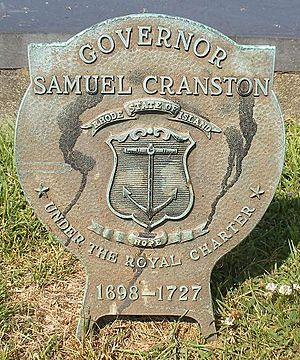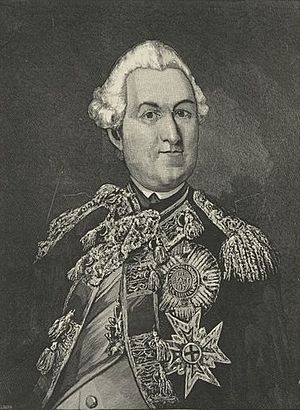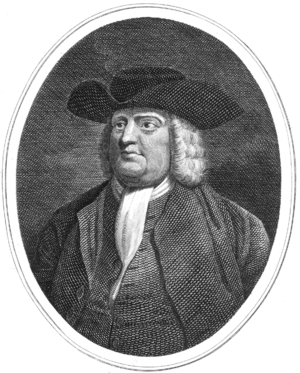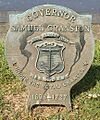Samuel Cranston facts for kids
Quick facts for kids
Samuel Cranston
|
|
|---|---|

Samuel Cranston grave medallion
|
|
| 18th Governor of the Colony of Rhode Island and Providence Plantations | |
| In office 1698–1727 |
|
| Preceded by | Walter Clarke |
| Succeeded by | Joseph Jenckes |
| Personal details | |
| Born | August 1659 Newport, Rhode Island |
| Died | April 26, 1727 Newport, Rhode Island |
| Resting place | Common Burial Ground, Newport |
| Spouses | (1) Mary Hart (2) Judith (Parrott) Cranston |
| Occupation | Goldsmith, Assistant, Major, Governor |
Samuel Cranston (1659–1727) was a governor of the Colony of Rhode Island and Providence Plantations. He served from 1698 to 1727. This means he was elected 30 times! He was governor longer than anyone else in Rhode Island's history.
Samuel was the son of a former Rhode Island Governor, John Cranston. He was born and lived his whole life in Newport. When he was young, he went to sea. Pirates captured him, and he was held for several years. Eventually, he returned home to his family.
Cranston did not have much political experience when he became governor in 1698. He took over after Walter Clarke resigned. The problems he faced early on were so serious that they threatened the colony's existence.
One big problem was piracy. Many privateers (people allowed to attack enemy ships during war) became pirates after the war ended. The King wanted piracy stopped. But many colonists liked the pirates. Cranston had to make tough choices to please England.
Another long-standing issue was the border between Rhode Island and Connecticut. Both colonies claimed the Narragansett area. This caused arguments for decades. During Cranston's time as governor, this dispute finally ended. Rhode Island won the argument.
A major challenge began in 1698. Lord Bellomont arrived as Governor of New York, Massachusetts, and New Hampshire. Bellomont disliked how Rhode Island was run. He sent many reports to England, listing problems. Bellomont wanted Rhode Island to lose its charter. This would put it under closer royal control. He might have succeeded, but he died in 1701.
After his first three years, Cranston became very popular. He was strong and made good decisions. While other politicians came and went, he stayed governor. He was re-elected every year until he died in 1727.
His first wife was Mary Hart. She was a granddaughter of Roger Williams. His second wife was Judith, who was the widow of his younger brother, Caleb. Cranston is buried in the Common Burying Ground in Newport. He shares a large tombstone with his father.
Contents
Early Life and Adventures
Samuel Cranston was born in Newport. His father, John Cranston, was also a governor. His mother was Mary Clarke. She was the daughter of an early colonial President, Jeremiah Clarke. Samuel was the oldest of ten children. He became a merchant and a goldsmith.
In 1684, at age 24, Cranston became a freeman from Newport. This meant he had full rights as a citizen.
Cranston had an amazing adventure as a young man. After he got married, he went to sea. Pirates captured him, and he was gone for many years. His family thought he was dead. His wife even planned to marry another man. But Cranston escaped! He returned to Newport on the night of his wife's wedding. He found her before the ceremony. The wedding turned into a celebration of his return. The groom-to-be was very understanding.
Cranston started his political career in his late 30s. He became an Assistant in 1696. Two years later, in 1698, he became a Major for the island's militia. That same year, he was chosen as governor. This happened when his brother-in-law, Walter Clarke, resigned.
Governing Rhode Island
Dealing with Pirates

Cranston was first elected governor in March 1698. He was re-elected two months later and every May after that until 1726. This means he was elected 30 times!
One of his first big tasks was to stop piracy. During the recent war with France, many ships were given permission to be privateers. They attacked French ships. But after the war, many of these privateers became pirates. This was a problem for all of New England, New York, and the West Indies.
In 1698, a law was passed to stop piracy. It said that illegally gained property would be taken. Pirates would be punished. The colony also sent a letter to the King. They admitted they had been slow to follow trade rules. But they also explained why they had allowed privateering. They asked the King to let Rhode Island keep its charter.
Cranston also wrote to the Board of Trade in England. He apologized for problems, like not sending enough troops to New York. He also explained the piracy charges. He said two suspected pirates would be put on trial.
Edward Randolph, a customs officer, wrote a harsh letter about Rhode Island. He claimed the colony was helping pirates. He even wrongly suggested that many colonists wanted a royal governor.
In October 1698, the General Assembly prepared for Lord Bellomont's visit. He was the new governor of New York and Massachusetts. They also worked on a list of laws to send to England. Another group was formed to discuss the border issue with Connecticut with Bellomont. England also sent new orders to governors to arrest the famous pirate, Captain Kidd.
Problems with the Colony's Rules
In December 1698, the Board of Trade told the King about Rhode Island's problems. They said the colony refused to take oaths, allowed illegal trade, and resisted royal authority. They suggested sending someone to investigate. Their goal was to take away Rhode Island's charter.
In May 1699, Rhode Island's agent in England, Jaleel Brenton, shared news. Connecticut was claiming parts of Warwick and Providence. Cranston wrote a long letter to the Board of Trade. He said many bad reports about Rhode Island were false. Meanwhile, Lord Bellomont moved to Boston. He was sick, which made him even more critical of Rhode Island.
Lord Bellomont: Rhode Island's Opponent
Bellomont wanted to stop piracy. This was hard because many important families were involved. He managed to trick Captain Kidd into coming to Boston, where he was arrested. Bellomont sent nearly 100 documents to England. These supported his claims against Rhode Island. He also asked members of the Admiralty Court to find evidence against pirates.

In August 1699, the Board of Trade sent a very stern letter to Cranston. They criticized the colony for not sending a full copy of its laws. They also strongly blamed Rhode Island for encouraging piracy. They mentioned privateer permissions given by Deputy Governor John Greene in 1694.
These serious issues led Cranston to call a special meeting. They discussed Bellomont's visit and the border with Connecticut. They also needed money to hire another agent in England. This agent would help defend the colony.
Bellomont kept a diary of his visit to Rhode Island. He was met by Cranston and escorted to Newport. They discussed the problems. Former governors and Cranston himself were questioned. They talked about the issue of oaths. Many in Rhode Island, especially Quakers, had religious reasons not to take oaths. This was hard for the English officers to understand.
The governors of Rhode Island and Connecticut discussed the Narragansett land dispute. They couldn't agree. Bellomont told them to send their claims to the King in England.
Bellomont gathered a huge amount of evidence against Rhode Island. He sent a report to the Privy Council (the King's advisors). It was a very strong document. It listed 25 different problems with Rhode Island's government. Historians wondered how the colony survived such attacks. It was a huge challenge for Rhode Island. Bellomont also accused Cranston of helping pirates. He even ordered that taxes not be collected in the Narragansett area.
Cranston showed great strength during this time. He issued arrest warrants for people who refused to pay taxes. This firmness helped save the colony from being taken over.
In December 1699, a copy of the colony's laws was sent to Bellomont. But he said it was not complete or correct. The Board of Trade then told the King that Rhode Island should be put under better control. In May 1700, John Greene, the deputy governor, was replaced. Cranston wrote to the King, asking to keep the charter. He also told the Board of Trade that Greene had been removed because of his past actions. He promised a better copy of the laws.
Lord Bellomont continued to criticize Rhode Island. But in March 1701, he died in New York. This was a huge event for Rhode Island. Bellomont was the strongest opponent to Rhode Island's charter.
Later Issues

In 1702, a fort was ordered to be built in Newport. That same year, Governor Joseph Dudley of Massachusetts visited Newport. He claimed authority over Rhode Island's military and courts. Cranston denied his claims. However, the new Queen Anne later granted Dudley some authority. Dudley wanted to take away Rhode Island's charter. But William Penn had great influence with Queen Anne. He helped Rhode Island keep its charter.
In 1703, the border between Rhode Island and Connecticut was finally settled. It was agreed to be the same line as in Rhode Island's charter. The colony was also divided into two counties. Rhode Island County included the islands. Providence Plantations included the mainland.
In 1702, the Royal African Company lost its monopoly on the slave trade. This allowed Rhode Island merchants to trade slaves directly. Rhode Island mostly got slaves from Barbados. In 1708, a tax of three pounds was put on each imported slave.
The first census of the colony was in 1708. It counted 7,181 people. This included 1,015 landowners, 426 slaves, and 56 indentured servants. The militia had 1,362 men. Each man needed a musket, sword, and ammunition.
Money Matters
To pay for the war against the French and Indians (called Queen Anne's War), the colony printed paper money. In July 1710, they printed 5,000 pounds in bills of credit. Farmers liked this idea, but merchants did not. Printing paper money caused many problems for the colony's economy for nearly a century.
Cranston approved the first paper money. He continued to approve more. This led to two political groups: the "hard-money" party (who wanted real coins) and the "paper-money" party. This caused big changes in elections. In May 1714, the hard-money party won. Most of the old leaders were replaced. The next year, in May 1715, was even more dramatic. The deputy governor and almost all the assistants were replaced. But Cranston remained governor. He was too skilled and respected by both sides to be removed.
End of His Time in Office
Queen Anne's War ended in 1713 with the Treaty of Utrecht. This brought peace. Rhode Island began to focus more on business, trade, and finance.
Many laws were passed in Cranston's last ten years. In 1718, a new militia law was made. It declared the Governor as the "Captain-General and Commander in Chief." The first printed laws of Rhode Island came out in 1719. In 1723, the first almshouse (a place for the poor) was built in Newport. In 1725, towns could build houses of correction for homeless or "mad persons." This was the first step towards social welfare institutions.
Family and Legacy
Cranston first married Mary Hart. She was the granddaughter of Roger Williams. They had seven children. After Mary died in 1710, Cranston married Judith (Parrott) Cranston. She was the widow of his younger brother, Caleb.
Samuel Cranston died on April 26, 1727, in Newport. He was still governor when he passed away. He is buried in the Common Burial Ground in Newport, next to his father. A large stone slab marks their grave. It has an inscription and a coat-of-arms. There is also a governor's medallion at his grave.
Rhode Island historian Samuel G. Arnold wrote about Cranston. He said Cranston held his position longer than almost anyone else elected annually. He was chosen governor 30 times. Arnold noted Cranston's great strength during difficult times. This was key to his amazing popularity.
Images for kids


